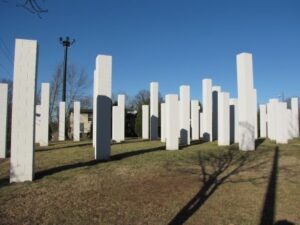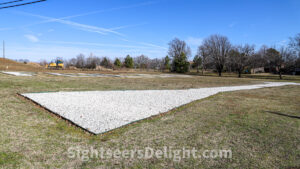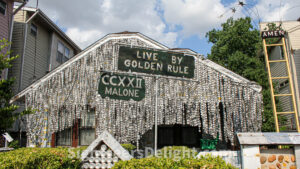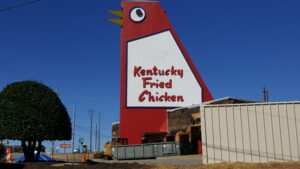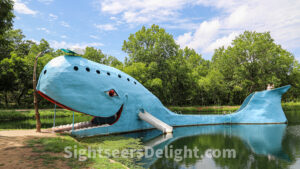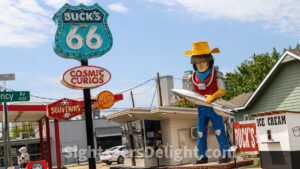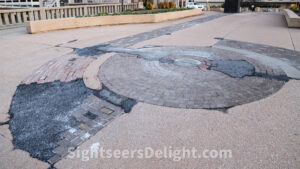54 Columns is a collection of 54 columns ranging from 10 to 20 feet tall. It was created in 1999 by Sol LeWitt, a minimalist artist. Known to some as Ghetto Stonehenge, the columns are supposed to resemble the Atlanta skyline. The art project was commissioned by the Fulton County Arts Council. In 2007, the Atlanta City Council designated the 210-acre Freedom Park, which is home to 54 Columns, as an Atlanta Public Art Project. LeWitt’s works can be seen in a number of museums nationwide, including the High Museum of Art in Atlanta. The Connecticut-born LeWitt died in 2007 at the age of 78.
30312
74106
From the late 1960s until he died in the 1980s, John Milkovisch covered his house on Malone Street with crushed been cans. The house — today affectionately know as the Beer Can House — opened in 2008 as a folk art museum. For a small fee, visitors can tour the house and learn more about more about Milkovisch’s passion. From the late 1960s until he died in the 1980s, John Milkovisch covered his house on Malone Street with crushed been cans. The house — today affectionately know as the Beer Can House — opened in 2008 as a folk art museum. For a small fee, visitors can tour the house and learn more about more about Milkovisch’s passion. “They say every man should leave something to be remembered by. At least I accomplished that goal,” one Milkovisch quote painted on an interior wall reads.
77007
After the fall of the Berlin Wall in 1989-90, portions of the structure wound up in communities worldwide. One section of the former Berlin Wall today stands on Long Wharf in downtown Portland.
The Big Chicken, located along Cobb Parkway in southern Marietta, is a true Atlanta landmark. Motorists reference the 56-foot-tall big chicken when giving directions. Radio stations mention it when describing traffic. Airplane pilots even use it as a landmark for navigation. Today, the Big Chicken is a bit of an anomaly, something unique at a fast food restaurant. Cobb Parkway is a string of urban sprawl, one fast food joint after another. Originally built as more or less a marketing gimmick, the chicken has been embraced by locals and has remained a landmark for more than 45 years. After it was damaged by a storm in 1993, KFC debated whether to rebuild the Big Chicken. The community seemed to be in agreement: The Big Chicken was a local landmark, and it needed to remain; KFC shelled out $700,000 to rehabilitate the restaurant and return the giant bird to working order. Today’s incarnation of this local icon features a moving beak and rotating eyes.
30062
By the 1920s, apples were becoming an important crop in parts of the state, including Cornelia. Because of the crop diversification, Habersham County skirted the devastating effects of the boll weevil’s destruction of the cotton crop. In 1925, Southern Railway donated to the city a monument dedicated to the fruit that helped save their community. The seven-foot- tall, 5,200-pound apple statue was molded in Winchester, Va., and sits atop an eight-foot- tall concrete pedestal next to the train depot. The apple was dedicated on June 4, 1926, and a number of dignitaries, including U.S. Sen. Walter F. George attended the event. By the mid 1930s, the apple crop nearly spelled doom from the city, but the statue remained as a reminder of the city’s past.
30531
Hugh Davis built the Blue Whale of Catoosa, a waterfront structure, in the early 1970s as an anniversary gift to his wife, Zelta, a collector of whale figurines. Since then, the whale has become one of the most recognizable attractions along Route 66. The pond surrounding the whale was initially fed by a spring and intended only for family use. However, it was later a popular swimming spot for locals and passersby, though today, swimming is prohibited. The Davis family closed the landmark to the public in 1988, but it has since been restored and re-opened.
74015
Buck Atom’s Cosmic Curios is a souvenir shop celebrating Route 66. Visitors often visit the shop, housed in a renovated 1950s PEMCO gas station, for a chance to see Buck Atom, a 21-foot-tall space cowboy-themed “muffler man.” Buck Atom debuted in Tulsa in 2019.
74120
The Cardrona Bra Fence in Central Otago, New Zealand, is a quirky and controversial tourist “attraction.” The “attraction” dates to sometime between Christmas 1998 and New Year 1999. Apparently, passers-by began attaching bras to a rural fence near the Cardrona Distillery. The original reason for doing so remains unknown, but the number of bras quickly grew, reaching hundreds. By early 2006, about 800 bras adorned the fence, drawing attention from far-away media sources. Although popular with visitors, the fence has sparked debate over its value as an attraction.
The Center of the Universe is a unique concrete circle in Tulsa with an acoustic anomaly. The circle is a little over eight feet in diameter, and any noise inside it echoes loudly. However, only those inside the circle can hear the echo. Surprisingly, these loud sounds cannot be heard from outside the perimeter of the brick structure. Visitors can access downtown Tulsa’s Center of the Universe through a brick path leading visitors from the Boston Avenue pedestrian overpass.
74103

